SCENIC TRAIL ST IVES TO LANDS END
The coast road from the famous resort of St Ives to the equally renowned beauty spot of Lands End is full of interest and hidden delights for the more adventurous and discerning traveller. The road meanders up hill and down dale through starkly dramatic countryside dotted with old mine-workings, ancient stone walls and granite-built farmhouses framed against a colourful canvas of gorse and verdant countryside dropping sharply down rugged cliffs to the sea below. Those prepared to take a little time and move away from the beaten track to discover this beautiful and unspoiled part of Cornwall will be amply rewarded by all it has to offer .

St Ives, Zennor, Gurnard's Head
The B3306 road out of St Ives toward St Just and Lands End quickly leads into open countryside with a patchwork of typically irregular fields and stone walls, providing an instant echo of the history of the area reaching as far back as the iron age. The road continues past outstanding rock formations silently and majestically silhouetted against the skyline, affording atmospheric glimpses of a pagan past to fire the imagination and transport the mind into a world of ritual, magic and demons. The progression from pagan past to Christianity remains in evidence, etched by the landscape and its existing monuments, as does the more recent transition from a community sustained by tin mining, farming and fishing to one in large part dependent upon the interest of visitors. For those prepared to engage their imagination further, the landscape bears testimony to the grit of the Cornish working people of recent history who toiled on the land and down the mines, returning from lowly paid, grindingly hard and often dangerous work to houses poorly lit, sparsely heated and devoid of running water. It is this very dance between people and landscape that forms a whole picture, together with a true understanding and appreciation of the terrain and of the people who inhabit it.
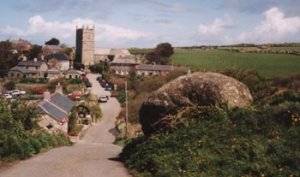 Some
three miles out of St Ives is the picturesque village of Zennor, snuggling
in its own little valley with typically prominent church steeple heralding
its arrival. At the top of the road leading into the village is a large
stone reputed to have been used as a pulpit for John Wesley to convert
the local sinners to Methodism in the 1750's. Halfway down the hill
is the Wayside Folk Museum, providing a historic insight into the lives
of working people in West Penwith and including a range of obsolete
cooking, farm and fishing implements. At the bottom of the hill is the
church, complete with its own cautionary reference to the colourful
local legend of the mermaid, which should not be spoiled by prior explanation.
If the traveller is by this time in need of a rest the Tinners
Arms is close at hand, as it was for the weary Tin Miners in
times gone by. The village also offers the Zennor
Backpackers & Cafe situated in the recently converted old
Methodist chapel.
Some
three miles out of St Ives is the picturesque village of Zennor, snuggling
in its own little valley with typically prominent church steeple heralding
its arrival. At the top of the road leading into the village is a large
stone reputed to have been used as a pulpit for John Wesley to convert
the local sinners to Methodism in the 1750's. Halfway down the hill
is the Wayside Folk Museum, providing a historic insight into the lives
of working people in West Penwith and including a range of obsolete
cooking, farm and fishing implements. At the bottom of the hill is the
church, complete with its own cautionary reference to the colourful
local legend of the mermaid, which should not be spoiled by prior explanation.
If the traveller is by this time in need of a rest the Tinners
Arms is close at hand, as it was for the weary Tin Miners in
times gone by. The village also offers the Zennor
Backpackers & Cafe situated in the recently converted old
Methodist chapel.
Back on the road again, the traveller might like to stop for a spell to look at Designer Hand Knits, sample a Cornish cream tea or take B & B accommodation at the stunningly situated Tregeraint House with its far-reaching vista over Gurnard's Head and the sea, with the Scilly Isles on the horizon. Alternatively, The Gurnard's Head Hotel , recently completely refurbished and extended, now offers a varied menu all day long together with high quality accommodation. From the side of the inn one can walk to the headland and enjoy the stunning views overlooking Gurnard's Head and the ocean or follow the track down to the idyllic Chy Barnett self-contained holiday cottage, set in the heart of Rosamunde Pilcher territory.
Gurnard's Head, Morvah, Pendeen
Leaving the Gurnard's Head, on the left are Carn Galvor, Hannibal's Carn and Watchcroft, the highest hill in West Penwith. Continuing along a winding road between the now familiar stone hedges the nature-lover may spot any number of unfamiliar migratory birds whose first port of call is the jutting peninsula, be charmed by exotic-looking chickens strutting their stuff in the middle of the road or encounter an outraged dog snapping at the wheels of the car in protest. Badgers in this region are a not uncommon sight at dusk, together with a wide variety of smaller nocturnal creatures regularly caught in the headlights.
A little further on is the climbing school beside the ruins of Carn Galvor Mine and if climbing seems like too strenuous a pastime it is well worth stopping here just to enjoy the view or to take a walk along the cliff top path, if only to marvel at the Mediterranean hue of the sea.
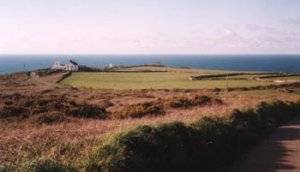 Many
an artist has been drawn to this area over the years, both by its outstanding
beauty and by the extraordinary quality of the light. D.H. Lawrence stayed in
a small hamlet along this road with Frieda during the first world war, only
to be driven out by accusations of flashing messages to enemy ships. An unfortunate
historical incident that probably says more about local paranoia than about
the veracity of the accusation but wars are prone to create such instances of
misunderstanding through fear, so the less said about it the better. A little
further along was, until very recently, the home of the internationally renowned
artist Patrick Heron (now,sadly, deceased) while the Newlyn Art Gallery and
St Ives Tate attract artistic attention from far and wide. The Bernard Leach
legacy has attracted any number of potters to the surrounds of St Ives, providing
a comprehensive choice of widely varying ceramic art, some of which reflecting
the unique nature and quality of the surroundings.
Many
an artist has been drawn to this area over the years, both by its outstanding
beauty and by the extraordinary quality of the light. D.H. Lawrence stayed in
a small hamlet along this road with Frieda during the first world war, only
to be driven out by accusations of flashing messages to enemy ships. An unfortunate
historical incident that probably says more about local paranoia than about
the veracity of the accusation but wars are prone to create such instances of
misunderstanding through fear, so the less said about it the better. A little
further along was, until very recently, the home of the internationally renowned
artist Patrick Heron (now,sadly, deceased) while the Newlyn Art Gallery and
St Ives Tate attract artistic attention from far and wide. The Bernard Leach
legacy has attracted any number of potters to the surrounds of St Ives, providing
a comprehensive choice of widely varying ceramic art, some of which reflecting
the unique nature and quality of the surroundings.
On through the tiny hamlet of Morvah, which can easily be overlooked. Curving in a horseshoe off the main road this was once a bustling mining village with a number of shops but is now solely residential except for a 'board' school and a recently opened gallery, however both merit the small detour. A short distance further on, through the equally tinyt hamlet of Bojewyan, is the former mining village of Pendeen, which is of sufficient interest to spend a little time exploring.
Pendeen, Trewellard, St Just
The village of Pendeen consists of a Church, a Post Office, a general stores, two pubs, a Gem and Jewellery Workshop, a pottery, a general stores and a fish and chip shop. On entering the village on the right hand side is The Radjel (meaning a pile of stones where a fox makes its home) which provides accommodation, a varied menu and a separate room with a pool table. A little further down on the left is the Gem and Jewellery Workshop, opposite which can be found The Old Counthouse (an ex tin-mining accounting house, as the name suggests) offering B & B accommodation amid lovely grounds in a quiet location and where the traveller can also rest and enjoy a Cornish cream tea in this lovely old house. Almost next door is Boscaswell Stores, offering all the provisions needed for the holiday cottage and hot and cold refreshments for the traveller.
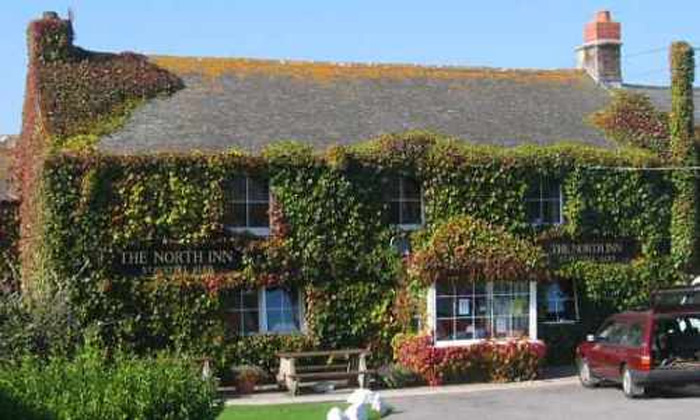
The village Post Office leading to The
North Inn, a traditional Cornish Inn offering good, home-cooked food
and B&B accommodation and with the added bonus of a large, attractive garden
at the rear looking out 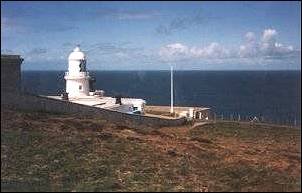 towards
the Atlantic Ocean. Opposite the car park is a road leading to Pendeen lighthouse
(now open to the public) which on a foggy day issues a mournful warning to ships
that evokes all the emotions wrought by past tragedies and mysterious happenings
off the treacherous, rocky coast but which, on a sunny day, is a beauty spot
well worth seeing. The active may like to take a relatively short walk down
to Boat Cove from the lighthouse and swim in the sun-warmed rock pool (deep,
only for swimmers) and, if fortunate, spot a seal playing in the sheltered cove
or watch a working boat come in with its catch. Alternatively, follow the coastal
path across the top to Portheras beach. Either way, the scenery and colours
are spectacular. On the way back the road passes Pendeen Manor Farm, beside
which can be found the Pendeen Fougou. The word 'fougou' is an old Cornish word
once used to describe both man-made and natural caves that are believed to date
back to the early Iron Age. Their function, however, remains an archeological
enigma on which there is as yet no universal agreement, which gives their exploration
an added tinge of speculative interest.
towards
the Atlantic Ocean. Opposite the car park is a road leading to Pendeen lighthouse
(now open to the public) which on a foggy day issues a mournful warning to ships
that evokes all the emotions wrought by past tragedies and mysterious happenings
off the treacherous, rocky coast but which, on a sunny day, is a beauty spot
well worth seeing. The active may like to take a relatively short walk down
to Boat Cove from the lighthouse and swim in the sun-warmed rock pool (deep,
only for swimmers) and, if fortunate, spot a seal playing in the sheltered cove
or watch a working boat come in with its catch. Alternatively, follow the coastal
path across the top to Portheras beach. Either way, the scenery and colours
are spectacular. On the way back the road passes Pendeen Manor Farm, beside
which can be found the Pendeen Fougou. The word 'fougou' is an old Cornish word
once used to describe both man-made and natural caves that are believed to date
back to the early Iron Age. Their function, however, remains an archeological
enigma on which there is as yet no universal agreement, which gives their exploration
an added tinge of speculative interest.
 Beside
the car park in the village is a walk up to Carn Eanes, about which abound numerous
tales of UFO sightings and strange goings-on that are open to individual interpretation.
There is no doubt, however, that its summit does have a weird and mystical quality
that defies explanation, and it most certainly provides a wonderful panoramic
view of the horizon from Lands End to The Gurnard's Head and beyond.
Beside
the car park in the village is a walk up to Carn Eanes, about which abound numerous
tales of UFO sightings and strange goings-on that are open to individual interpretation.
There is no doubt, however, that its summit does have a weird and mystical quality
that defies explanation, and it most certainly provides a wonderful panoramic
view of the horizon from Lands End to The Gurnard's Head and beyond.
Back on the road toward St Just, and if the weary traveller would like to stay awhile to enjoy the village hospitality and a few entertaining yarns. Geevor Mine, one of the last working tin mines in Cornwall to close, is now open for guided tours which take from one and a half to two hours to complete and sometimes need to be booked in advance during the height of the season, for which a stopover is well worthwhile and will provide a valuable insight into the history of the area.
Onward to St Just
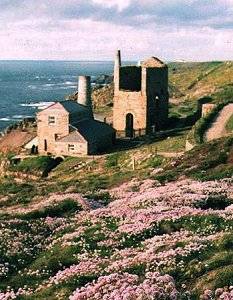 The
next stage of the journey will take the traveller into Trewellard, passing Geevor
Mine, the Trewellard Meadery and the Trewellard Arms Hotel, opposite which is
Fieldhouse, popular village tea rooms offering light lunches, afternoon teas
and B & B accommodation in the tranquil setting of an ex mining village.
Alongside is the ancient chapel and a road sign posted to Levant Steam Engine.
For anybody interested in the mechanics of working mines this will prove fascinating
to witness in action, whilst for those less interested Levant itself provides
another beautiful walk, with the added attraction of quite possibly witnessing
a hawk at close proximity stalking its prey, or of spotting a variety of birds
nesting on the sides of the cliffs. From Trewellard the road travels through
Carnyorth, with its rows of ex-miners' cottages, and on into Botallack. If the
traveller is still able to absorb the concept of enjoying breathtaking views
in splendid isolation, then follow the road into the village and along the track
sign posted 'Manor Farm' to witness one of the sites used for the filming of
'Poldark' and on to the ruins of Crown Mine with yet more of the stunning beauty
for which this area is noted. Through the village and on the left is the Queens
Arms, a typically Cornish Inn in which there is a strong possibility of encountering
some very pronounced Cornish accents.
The
next stage of the journey will take the traveller into Trewellard, passing Geevor
Mine, the Trewellard Meadery and the Trewellard Arms Hotel, opposite which is
Fieldhouse, popular village tea rooms offering light lunches, afternoon teas
and B & B accommodation in the tranquil setting of an ex mining village.
Alongside is the ancient chapel and a road sign posted to Levant Steam Engine.
For anybody interested in the mechanics of working mines this will prove fascinating
to witness in action, whilst for those less interested Levant itself provides
another beautiful walk, with the added attraction of quite possibly witnessing
a hawk at close proximity stalking its prey, or of spotting a variety of birds
nesting on the sides of the cliffs. From Trewellard the road travels through
Carnyorth, with its rows of ex-miners' cottages, and on into Botallack. If the
traveller is still able to absorb the concept of enjoying breathtaking views
in splendid isolation, then follow the road into the village and along the track
sign posted 'Manor Farm' to witness one of the sites used for the filming of
'Poldark' and on to the ruins of Crown Mine with yet more of the stunning beauty
for which this area is noted. Through the village and on the left is the Queens
Arms, a typically Cornish Inn in which there is a strong possibility of encountering
some very pronounced Cornish accents.
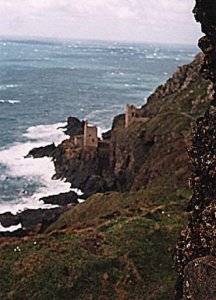 Out
onto the main road, past (or into) the Gallery at the foot of the hill and up
into the quaint old town of St Just with its historic Church, picturesque square
and ancient Plain an Gwarry (literally, 'playing place', built for the production
of the Miracle Plays performed in Cornish up to 1600 A.D.). Here the visitor
can enjoy Cornish hospitality in a number of hostelries, buy a Cornish pasty
in one of the bakeries or explore the narrow back streets to discover tea rooms,
pottery, galleries and numerous other delights including the impressive Church,
beside which is the tiny house in which John Wesley stayed whilst preaching
in the area.
Out
onto the main road, past (or into) the Gallery at the foot of the hill and up
into the quaint old town of St Just with its historic Church, picturesque square
and ancient Plain an Gwarry (literally, 'playing place', built for the production
of the Miracle Plays performed in Cornish up to 1600 A.D.). Here the visitor
can enjoy Cornish hospitality in a number of hostelries, buy a Cornish pasty
in one of the bakeries or explore the narrow back streets to discover tea rooms,
pottery, galleries and numerous other delights including the impressive Church,
beside which is the tiny house in which John Wesley stayed whilst preaching
in the area.
For those interested in the prevailing artistic influence in the region the town offers a number of galleries and craft shops displaying the work of a variety of local artists and craftspeople. Alternatively, or in addition, roads lead off to the idyllic Cot Valley (quaintly sign posted ot alley) with its famous round boulders or to Cape Cornwall, equally well known for its beautiful, rugged scenery and which is also the site of Cape Cornwall Leisure Centre and golf course, set in surroundings to rival Augusta. The determined sightseer might try to find Carn Gluze, leading to a point with views to the Longships (the rocks off Lands End)and with an ancient burial mound dating back to the Late Neolithic/Bronze age. If so, directions from St Just would be advisable.

